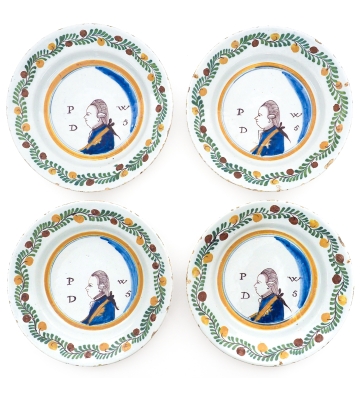These plates in blue, yellow, green red and manganese (purple) depicts Willem V (1748-1806), Prince of Orange and stadtholder of the Republic of The Seven United Netherlands. He is displayed in a medallion with a bow and the yellow finished border shows stylized flower and leaf work. The letters “PWD5” stands for ‘Prince (of Orange) Willem the Fifth’. These kinds of wears are produced for the support of parties in the civil war during the democratic revolution lasting in The Netherlands at the end of the 18th century. It was common to use plates, glasses, tokes and other dishes to display your political support against or in favor of the House of Oranje-Nassau. The rule of Willem V was marked by economic instability, colonial losses and triggered resentment among the Patriots, a faction of dissatisfied citizens longing to revive the Republic's former grandeur. In 1786, the lasting conflict between the Orangists (pro hereditary governorship of the House of Orange Nassau) and the Patriots (pro republic) compelled the Orange couple to flee in their own country away from the administrative center in The Hague. Eventually, with the help of his wife and intervention of Prussian troops, Prince Willem V regained control in 1787. Nevertheless, his authority over the country lasted for only a few years before Batavian revolutionaries invade the Netherlands.
Reference: A similar plate in the possession of Keramiekmuseum Princessehof Leeuwarden, inventory nr. GMP 1972-035.
























